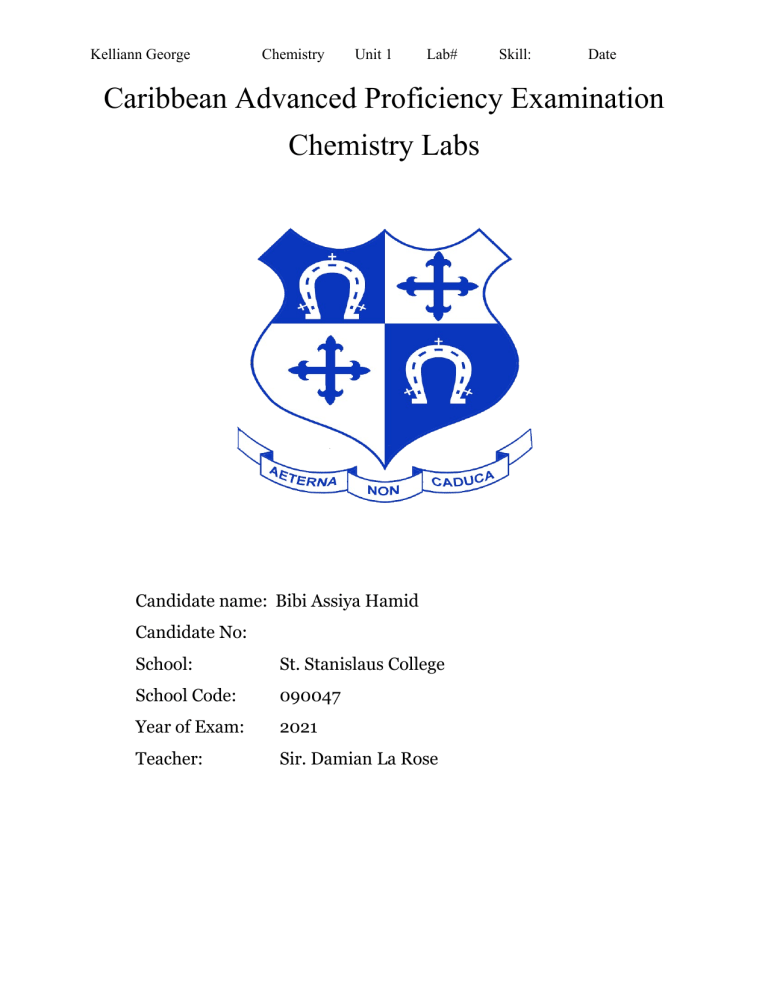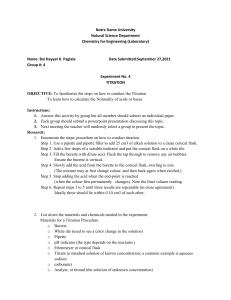
Kelliann George Chemistry Unit 1 Lab# Skill: Date Caribbean Advanced Proficiency Examination Chemistry Labs Candidate name: Bibi Assiya Hamid Candidate No: School: St. Stanislaus College School Code: 090047 Year of Exam: 2021 Teacher: Sir. Damian La Rose Kelliann George Chemistry Unit 1 Lab# Skill: Date TOPIC: Volumetric analysis AIM: To determine the unknown concentration of sodium hydroxide solution BACKGROUND INFORMATION: MATERIALS/APPARATUS: 2 beakers (100 mL) Sodium hydroxide (NaOH) 1 Burette (50 mL) 2 250 mL Erlenmeyer Flask Wash bottle Distilled water burette clamp stand Methyl orange indicator White tile 0.2 M Sulphuric acid solution METHOD: 1. A clean burette was rinsed with distilled water then with acid solution. 2. The burette was mounted on clamp stand. 3. Burette was then filled with acid solution to the zero mark (ensure no air bubbles are present). 4. 20 mL of the basic solution was pipetted into a clean conical flask 5. 2-3 drops of methyl orange was placed into the flask with acid. 6. Titration was left to occur (allow the acid solution from the burette to run into the base solution in the flask) until the first permanent colour change was observed. 7. Steps 4-6 was repeated three times to ensure that the titer value differs no more than 0.1 mL. DIAGRAM: Bibi Assiya Hamid Chemistry Unit 1 Lab# Skill: Date RESULTS/OBSERVATIONS: Burette Reading Initial reading Final reading Titre Trial 0.00 5.50 5.50 Titration Titration 1 Titration 2 5.50 11.50 11.50 17.3 6.00 5.80 CALCULATIONS: DISCUSSION: PRECAUTIONS: 1. Ensure air bubbles are not present in pipette 2. Keep chemical bottles off the bench and do not contaminate pipettes. SOURCE OF ERROR: Titration 3 17.30 23.00 5.7 Bibi Assiya Hamid Chemistry 1. 2. CONCLUSION: REFERENCES: TOPIC: Redox titration Unit 1 Lab# Skill: Date Bibi Assiya Hamid Chemistry Unit 1 Lab# Skill: Date AIM: To standardized a solution of potassium permanganate. BACKGROUND INFORMATION: Potassium manganate (VII) (potassium permanganate, KMnO4) solution can be standardised by titration against a standard solution of ammonium iron (II) sulfate solution. The iron (II) solution is measured by use of a pipette, whilst the potassium manganite (VII) solution is placed in a burette. The titration is carried out under acidic conditions, so the pipetted Fe+2 solution is acidified by addition of about 10 cm3 of dilute sulfuric acid before commencement of the titration. The reaction is represented by the equation: MnO + 8H+ + 5Fe+2 Mn+2 + 5Fe+3 + 4H2O No indicator is needed, as the manganite (VII) ions are decolourised in the reaction until the endpoint, when a pale pink colour persists. MATERIALS/APPARATUS: Potassium manganite (VII) solution 0.1 M ammonium iron (II) sulfate solution 1.5 M sulfuric acid solution Deionised (or distilled) water Safety glasses Pipette (25 cm3) Pipette filler Burette (50 cm3) Filter funnel Graduated cylinder (100 cm3) Conical flask (250 cm3) White tile White card Retort stand Boss-head Clamp Beakers (250 cm3) Wash bottle METHOD: Bibi Assiya Hamid Chemistry Unit 1 Lab# Skill: Date DIAGRAM: RESULTS/OBSERVATION Initial Final Titre Trial 0.00 13.8 13.8 1 13.8 27.5 13.7 2 27.5 41.1 13.6 3 0.0 13.6 13.6 Bibi Assiya Hamid Chemistry Unit 1 Lab# Skill: CALCULATIONS: DISCUSSION: PRECAUTIONS: 1. SOURCE OF ERROR: 1. REFERENCES: TOPIC: Molar Enthalpy AIM: To determine the enthalpy change for the displacement reaction: Date Bibi Assiya Hamid Chemistry Unit 1 Lab# Skill: Date Zn(s) + Cu2+(aq) → Zn2+(aq) + Cu(s) BACKGROUND INFORMATION: MATERIALS/ APPARATUS: Goggles Bench mat 25cm3 pipette Pipette filler Polystyrene cup with lid Weighing bottle Spatula Balance Thermometer Stop clock Zinc powder 1.0M copper(II) sulphate solution METHOD: 1. 25cm3 of CuSO4 (aq) was measured with a pipette and released into the polystyrene cup. 2. 5g of zinc was weighed in the weighing bottle. 3. The thermometer was placed through a hole in the lid, stirred and the temperature was recorded for every half minute for 2½ minutes in the table below. 4. The zinc was added to the cup at precisely 3 minutes. 5. Stirring continued and the temperature was recorded for an additional 6 minutes in the table below. DIAGRAM: RESULTS/ OBSERVATION: Time (minutes) Temperature(oC) Time (minutes) Temperature (oC) Bibi Assiya Hamid 0.0 0.5 1.0 1.5 2.0 2.5 3.0 3.5 4.0 4.5 Chemistry Unit 1 30o 30o 30o 30o 30o 30o not done Lab# Skill: 5.0 5.5 6.0 6.5 7.0 7.5 8.0 8.5 9.0 9.5 Date 30o 31.5o 32.5o 33.5o 35.5o 36.5o 37.2o 38o 38.2o 39.2o 39.5 39.9 40.1 40.2 40.1 40.05 40 CALCULATIONS: DISCUSSIONS: CONCLUSION: REFERENCES: TOPIC: Testing for Vitamin C. STATEMENT OF PROBLEM: With the covid pandemic present, doctors are advising that sanitation is important as well as strengthening our immune system with increase intake of Bibi Assiya Hamid Chemistry Unit 1 Lab# Skill: Date Vitamin C. As the health officer, you are required to advise the general populace on the better source of Vitamin C. HYPOTHESIS: Compared to emergency vitamin C powder, vitamin C tablets are the best source of vitamin C because it retains most of the vitamin C from its source. AIM: To compare and determine the source of Vitamin C that will best serve to strengthen the immune system against the covid- 19 virus. BACKGROUND INFORMATION: Vitamin C is a vitamin found in various foods and sold as a dietary supplement. It is involved in many body functions including; Formation of collagen, absorption of iron, the proper functioning of the immune system, wound healing and the maintenance of cartilage bones and healing vitamin c is an antioxidant. Antioxidants like vitamin c acts as a first target of reactive molecules like oxygen or iodide. This protects molecules critical to our health .The vitamin protects iodine from reacting with starch. Once all the vitamin c has reacted any additional iodine reacts with starch and blue black color is seen. MATERIALS/ APPARATUS: ● Vitamin C Tablet ● Emergency vitamin C powder ● Burette ● 6 test tubes ● Pipette ● Knife ● Beaker ● Test tube rack ● Starch solution ● Iodine solution METHOD: 1. Gather all equipment’s and ensure they are washed. Bibi Assiya Hamid Chemistry Unit 1 Lab# Skill: Date 2. Crush the 2 tablets separately after weighing them. 3. Dissolve tablets and emergency powder in two different volumetric flasks with 200ml of distilled water. 4. Mix starch solution and iodine solution in two different conical flasks. 5. Zero burette with iodine solution. 6. Combine 5ml of the dissolved emergency vitamin C powder with distilled and starch solution in a volumetric flask. 7. Burette iodine solution into the volumetric flask swirling until the first permanent blue black color change appears through out the entire solution. 8. Record the initial and final titration graduation. Repeat two more times with the same mixture. And then three more times, using the crushed vitamin C tablets instead of emergency vitamin C powder. 9. Record results found. EXPECTED RESULTS: Title- Table showing expected results of Vitamin C test Vitamin C Agents Trial 1 Trial 2 Trial 3 Vitamin C tablet Initial value Final value Titre Emergen-C Initial value Final value Titre TREATMENT OF RESULTS After the results are collected, find the value that represents the unknown solution. VARIABLES: Bibi Assiya Hamid Chemistry Unit 1 Lab# Skill: Date ● Control- the amount of dissolved vitamin C, distilled water and starch solution used. ● Independent- amount of iodine solution used. ● Dependent- colour change PRECAUTIONS: 1. Ensure air bubbles are not present in burette. 2. Be careful when handling lab equipment. 3. Avoid skin and eye contact with all chemicals. TITLE: Identification of cations AIM: To observe the colour of various metal ions when placed in a flame. BACKGROUND INFORMATION: Bibi Assiya Hamid Chemistry MATERIALS/ APPARATUS: Inert metal loop Bunsen burner Potassium Barium Calcium Strontium Lithium Sodium Copper METHOD: 1. HGHN DIAGRAM: OBSERVATION/ RESULTS: CALCULATIONS: Unit 1 Lab# Skill: Date Bibi Assiya Hamid Chemistry Unit 1 Lab# Skill: DISCUSSION: PRECAUTIONS: 1. Ensure air bubbles are not present in pipette 2. Keep chemical bottles off the bench and do not contaminate pipettes. SOURCE OF ERROR: 1. 2. CONCLUSION: REFERENCES: TITLE: Heat of Solution AIM: Date Bibi Assiya Hamid Chemistry Unit 1 Lab# Skill: Date 1. To measure experimentally the amount of heat involved in the dissolving of ammonium nitrate in water. 2. To relate the heat of solution involved to the two-step process of dissolving. BACKGROUND INFORMATION: MATERIALS/ APPARATUS: 2 Styrofoam cups thermometer 100 mL graduated cylinder balance stirring rod ammonium nitrate, NH4NO3 METHOD: 1. The mass of a sample of solid ammonium nitrate of approximately 5 grams was found. 2. The mass of a dry pair of Styrofoam cups was found. 3. 50 mL of distilled water was added to the cup and the mass of the cup and water was found. 4. The water was stirred briefly with a thermometer and the temperature was recorded. 5. The solid was dissolved in the water, stirred with the thermometer and the maximum temperature difference from the initial reading was recorded. DIAGRAM: OBSERVATION/ RESULTS: Data Tables Bibi Assiya Hamid Chemistry Unit 1 Lab# Skill: Date Ammonium nitrate Sodium acetate Mass of empty styrofoam cup = g g Mass of cup and water = g g Mass of NaOH used = g g Initial temperature of H2O = o C o Final temperature of H2O = o o C C C CALCULATIONS: 1. From your data, calculate the following for each part of the experiment. a) the temperature change of the water. b) the mass of water. c) the quantity of heat absorbed (or given off) by the water during the dissolving. d) the number of moles of solid used. e) the quantity of heat involved per mole of solid dissolved. This is called the molar heat of solution. Ammonium nitrate Sodium acetate Mass of H2O used = g g Formula of solid = ____________ ____________ Molecular mass of solid = g/mol g/mol Number of moles of solid = mol mol Temperature change = o C o Energy released in reaction = kJ kJ Research- What is the accepted value of the heats of solution for the above solid? Ammonium Nitrate = _____________________ kJ/mole The formula weight of NH4NO3 is 80.04g/mol. C Bibi Assiya Hamid Chemistry Unit 1 Lab# Skill: DISCUSSION: PRECAUTIONS: 1. Ensure air bubbles are not present in pipette 2. Keep chemical bottles off the bench and do not contaminate pipettes. SOURCE OF ERROR: 1. 2. CONCLUSION: REFERENCES: TITLE: Rates of Reaction AIM: BACKGROUND INFORMATION: Date Bibi Assiya Hamid Chemistry MATERIALS/ APPARATUS: METHOD: DIAGRAM: OBSERVATION/ RESULTS: CALCULATIONS: DISCUSSION: Unit 1 Lab# Skill: Date Bibi Assiya Hamid Chemistry PRECAUTIONS: 1. SOURCE OF ERROR: 1. 2. CONCLUSION: REFERENCES: Unit 1 Lab# Skill: Date
